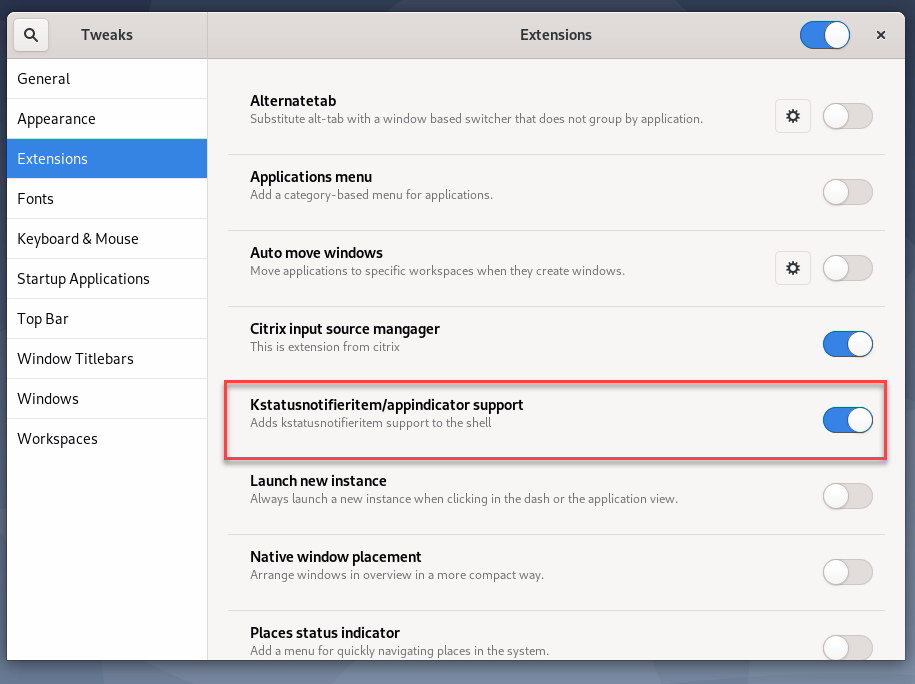Client battery status display
The Linux VDA can redirect and display the battery status of client devices in virtual desktops. This feature is enabled by default and available for the following versions of Citrix Workspace™ app:
- Citrix Workspace app for iOS
- Citrix Workspace app for Linux
- Citrix Workspace app for Mac (version 2204.1 is not supported)
- Citrix Workspace app for Windows (version 2204.1 is not supported)
Overview
When users open a virtual desktop, they can see a battery icon in the Linux system tray. The battery icon indicates the battery status of their client devices. To check for the percentage of remaining battery life, click the battery icon. For example, see the following screen capture:
![]()
Different battery icons indicate different battery statuses. For an overview, see the following table:
| Battery icon | Charging status | Level of remaining battery life | Percentage of remaining battery life |
|---|---|---|---|
 |
Charging, indicated with a “+” symbol | High, indicated with a green color |
|
 |
Charging, indicated with a “+” symbol | Medium, indicated with an amber color |
|
 |
Charging, indicated with a “+” symbol | Low, indicated with a red color | < 20% |
 |
Not charging, indicated with a “-“ symbol | High, indicated with a green color |
|
 |
Not charging, indicated with a “-“ symbol | Medium, indicated with an amber color |
|
 |
Not charging, indicated with a “-“ symbol | Low, indicated with a red color | < 20% |
 |
Unknown | Unknown | Unknown |
Configuration
Client battery status display is enabled by default.
To disable the feature, run the following command:
/opt/Citrix/VDA/bin/ctxreg update -k "HKLM\System\CurrentControlSet\Control\Citrix\VirtualChannels\MrVc" -v "Enabled" -d "0x00000000"
<!--NeedCopy-->
To enable the feature, run the following command:
/opt/Citrix/VDA/bin/ctxreg update -k "HKLM\System\CurrentControlSet\Control\Citrix\VirtualChannels\MrVc" -v "Enabled" -d "0x00000001"
<!--NeedCopy-->
Note:
The preceding commands impact the soft keyboard feature, which shares the Mobile Receiver Virtual Channel (MRVC) with client battery status display.
Based on your distribution, complete the following extra steps:
-
If you are using RHEL 8.x or SUSE 15.x installed with GNOME, install a compatible extension for your GNOME shell to enable AppIndicator support:
-
Run the
gnome-shell --versioncommand to check your GNOME shell version. -
Download a compatible extension for your GNOME shell from https://extensions.gnome.org/extension/615/appindicator-support. For example, if your shell version is 3.28, you can select 24 or 26 for the extension version.

-
Untar the downloaded package. Verify that the “uuid” value in the metadata.json file in the package is set to appindicatorsupport@rgcjonas.gmail.com.
-
Run the
mvcommand to move the appindicatorsupport@rgcjonas.gmail.com directory to the location under/usr/share/gnome-shell/extensions/. -
Run the
chmod a+r metadata.jsoncommand to make the metadata.json file readable to other users.Tip:
By default, the metadata.json file in the appindicatorsupport@rgcjonas.gmail.com directory is readable only to the root user. To support screen sharing, make the metadata.json file readable to other users as well.
-
Install GNOME Tweaks.
-
In the desktop environment, reload your GNOME shell by pressing the
Alt+F2,r, andEnterkeys in sequence or by running thekillall -SIGQUIT gnome-shellcommand. -
In the desktop environment, run GNOME Tweaks and then enable KStatusNotifierItem/AppIndicator Support in the Tweaks tool.
-
-
If you are using Debian 11.3 or Debian 10.9 installed with GNOME, complete the following steps to install and enable GNOME system tray icons:
-
Run the
sudo apt install gnome-shell-extension-appindicatorcommand. You might have to log out and then back in again for GNOME to see the extension. -
Search for Tweaks in your Activities screen.
-
Select Extensions in the Tweaks tool.
-
Enable Kstatusnotifieritem/appindicator support.

-